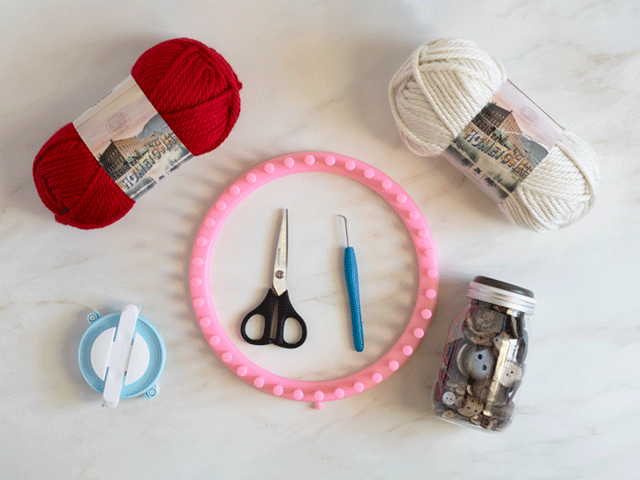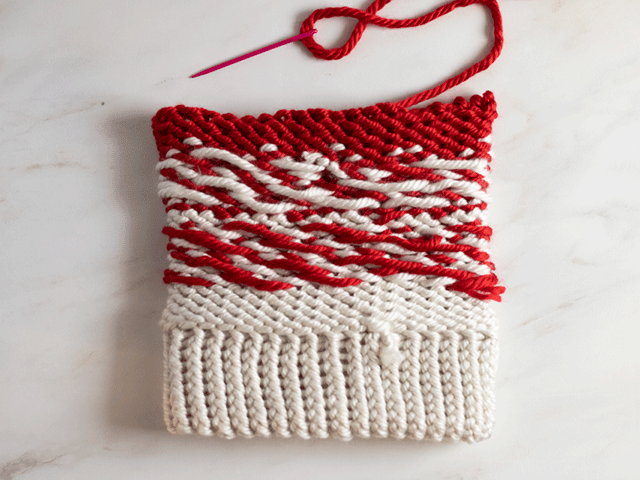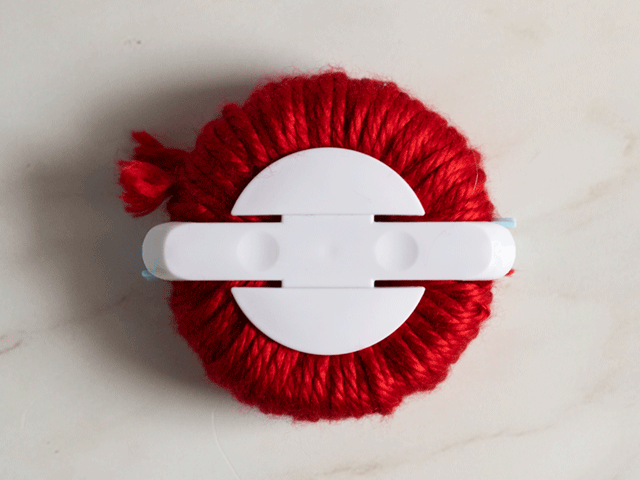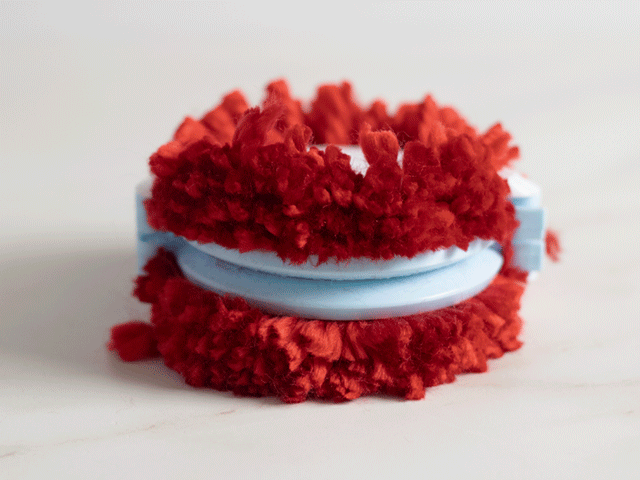
Nursing a newborn takes up a lot of my time these days. However, much of that time is spent sitting and scrolling with my phone. I decided to switch things up lately and see if it’s possible to loom knit during my nursing sessions. And surprisingly, I managed to loom knit a fair isle beanie this week (with the help of a quality nursing pillow).
This pattern started out as an experimental doodle with the Knitting Chart app on my iPad. I’m happy it turned out as well as it did. Now I’m sharing my design with you, so you can enjoy your own fair isle hat.
What is a Fair Isle Pattern?
The Fair Isle is one of the Shetland islands popularly known for their stranded knitting traditions. The Fair Isle sweater, in particular, often features complex geometric patterns using multiple colors, typically within a limited palette. Skilled crafters would use 5 or 6 colors, with no more than 2 colors in a row, worked in a round. Many Fair Isle knits also included natural motifs such as snowflakes, pine trees, or deer.
However, the Fair Isle name has since been simplified to mean stranded knits with repeating color work. Since the basic Fair Isle pattern only uses a basic e-wrap stitch, I figured a Fair Isle beanie would be a good project for beginning loom knitters.
What Materials Do You Need?
This Fair Isle beanie is a fairly simple project that beginning knitters should have no problem tackling. However, it does require a few basic materials: a loom, yarn, knitting hook, and scissors. If you want to make a Pom-Pom to go on top of your beanie, a Pom-Pom maker can help the job go a little smoother.

A Look at Your Loom
I haven’t been loom knitting for very long, so I don’t have a big collection of fancy looms. In fact, I bought a fairly cheap loom set* on Amazon for about $20 at the time. The set contained multiple round looms of varying sizes, and they had wide-spaced pegs that were perfect for my awkward beginning hands to work with.
However, you don’t have to use the exact same loom I do. I tried to make my step-by-step instructions as simple and versatile as possible. You should be apply to apply the same techniques no matter you loom size. So feel free to use whatever loom you have available.
If you want an exact match, my particular loom is a 9-inch loom with 36 pegs. The loom is a large gauge loom (5/8th inch) best suited for bulky size 5 or size 6 yarn.
*Just to be transparent, I am an Amazon Associate. Purchase from affiliate links I share do help keep my site running, as I receive a small commission . I don’t earn money for recommending specific products – so I only recommend items I use and enjoy regularly.
What Kind of Yarn to Use
Technically speaking, you can use just about any yarn you wish to loom knit a fair isle beanie. However, if you want a tight knit that will keep you warm, you’ll need to match your yarn to your loom.
Craft stores sell a variety of yarn lengths, widths, and textures. Before you cast yarn onto your loom, make sure your yarn is appropriate for the project. My large gauge loom works best with thick bulky yarn, so I chose two colors of Lion Brand Bulky yarn, size 6. This yarn is widely available at a variety of stores, and I often buy it at Wal-Mart whenever I see it on sale.
Double-check your loom size before you buy your yarn. If you have a smaller gauge, you could use a thinner yarn.
Extra Bits and Bobs
Once you have your yarn and your loom, you’re almost ready to start knitting. But don’t forget to have these basic tools on hand:
- Craft scissors
- Knitting needle or crochet hook
- Pom-Pom maker (optional)
- Buttons (optional)
- Tags (optional)
The last three items are purely decorative. I include how to make a Pom-Pom at the end of my tutorial, but you don’t have to make one yourself. You could buy a pre-made Pom-Pom or you could leave it off entirely. I also like to sew on a large button or a tag with my signature to give the hat a little extra flair, but how you finish your beanie is up to you.
How to Cast On
This Fair Isle beanie only requires one basic stitch: the e-wrap. No need to worry about purls or any other fancy stitching. The e-wrap cast-on, as you may have already guessed, looks more or less like the letter e when on the loom. Once you know how to e-wrap, you’ll finish your beanie in no time.
To start, tie a slip knot around the starting peg of your loom. My loom has an extra peg on the side that serves as a marker, but yours may have a little arrow or similar mark to help you keep track. If you don’t have a marker, you can begin anywhere, just so long as you can remember where you started.

Wrap the yarn around the adjacent peg with the loop on the outside and the strand on the inside. I prefer to go to the left, though you could go to the right if you are consistent. Then wrap each peg around your loom until you’re back at the beginning. Ideally, you’ll keep the yarn tight enough that it doesn’t slide up or down, but loose enough that you can pull it up and over the peg later. Once you’ve gone all the way around your loom, continue to e-wrap a second row.

When you’ve finished your second row, wrap your working yarn around the side marking peg a few times to hold it in place. If you don’t have that extra peg, you can simply hold the yarn tight while you work with your knitting hook.

Insert the hook into the loop of the slip knot. Pull the loop up and over the peg.

Be gentle with this first loop, as the slip knot can easily pull free and come undone. Repeat around the entire loom.
Congratulations! You’ve knitted your first row of your Fair Isle beanie.
Begin the Brim
Now that you’ve got one row under your belt, it’s time for some repetition. To create a nice thick brim like the one in the finished photo, you’ll need to knit about 15 to 20 rows. You can knit fewer rows if you want a thinner brim, or more rows if you want a thicker one. It’s up to you and your personal preference. If you want to match the picture exactly, knit 20 rows.

When you’ve knitted enough rows, you need to fold the bottom of your hat back up onto your loom. To do this, use your finger to trace the line of loops down from your starting peg until you find your initial slip knot.
Reach inside your loom, grab the loop to the left of the slip knot and pull it up over your starting peg. The grab the loop adjacent to the one you just lifted, and pull it over the next peg, too. Try to line each loop up with its matching peg until you’ve circled your loom.

Now that you have a new line of loops, you should have no problem knitting from here. Just insert your hook in the bottom loop.

And pull it up and over the top of the peg. Repeat this step until you’ve gone around the entirety of your loom.

Well done! You’ve finished the brim of your Fair Isle beanie.
Follow the Pattern
Now that the brim is finished, you can introduce your second yarn color and begin the geometric pattern that Fair Isle knits are known for.
To make things easy, I made this colored graph. The numbers on the right hand side going vertically represent the number of rows you’ll need to knit. The numbers on the top going horizontally are the number of pegs on your loom. My loom has 36 pegs, but it’s alright if your loom doesn’t match mine exactly. This particular pattern repeats itself so you can adjust it to fit your needs. Note: This graph does not include the brim.

If you struggle to read the graph, here’s a breakdown of my fair isle beanie pattern:
- Rows 1 through 4: E-wrap with your first yarn color (yarn 1)
- Row 5: E-wrap two pegs with yarn 1, cast on your second yarn color (yarn 2) on peg 3. E-wrap three pegs with yarn 1, and e-wrap 1 peg with yarn 2. Repeat 7 times. E-wrap the last peg with yarn 1.
- Row 6: Start with yarn 2 on the first peg. Then repeat 8 times the same pattern of three pegs with yarn 1 and one peg with yarn 2. E-wrap the last three pegs with yarn 1.
- Row 7: Start with yarn 1 on the first peg. E-wrap with yarn 2 on the second peg. Continue to alternate every peg with the two colors.
- Row 8: The same as row 6.
- Row 9: The same as row 5.
- Row 10: E-wrap the entire row with yarn 1.
By now, your Fair Isle beanie will look like this if you were to pull it up through the loom. Most of the time, your knit will fall through the center naturally.

And now it’s time to flip the colors!
- Row 11: E-wrap the entire row with yarn 2.
- Row 12: E-wrap two pegs with yarn 2, e-wrap with yarn 1 on peg 3. E-wrap three pegs with yarn 2, and e-wrap one peg with yarn 1. Repeat 7 times. E-wrap the last peg with yarn 2
- Row 13: Start with yarn 1 on the first peg. Then repeat 8 times the same pattern of three pegs with yarn 2 and one peg with yarn 1. E-wrap the last three pegs with yarn 2.
- Row 14: Start with yarn 2 on the first peg. E-wrap with yarn 1 on the second peg. Continue to alternate every peg with the two colors.
- Row 15: Same as row 13.
- Row 16: Same as row 12. Tie off yarn 1.
- Rows 17-20: E-wrap everything with yarn 2.
And you’re done! Here’s what you should have at this point:

I hope the pattern didn’t get too muddled along the way. I accidentally left off row 16, but I thought the final beanie still looked nice as it was. It can be tough alternating strands, but the final effect is striking.
Finishing Up
Once you’ve finished knitting your rows, you can remove your hat from the loom – but don’t just pull it off the pegs! You need to prep it first.
Wrap your second colored yarn one and a half times around your loom, and cut it. Then, thread the end of the yarn through a yarn needle. Insert the needle through the bottom of your loop, and pull until the loop slides up and off the peg. Repeat with the adjacent loop, coming up through the bottom each time.

Once you’ve worked your way around the loom, your hat will naturally slide off. Knot and tuck in any loose ends from your yarn.

Then, pull on your secondary yarn color to cinch the top of the hat. Don’t worry about pulling your hat super tight – you’ll use your excess yarn to stitch up the hole in the top.

To cover up the hole, I prefer to make an x-shaped stitch. I simply go back and forth until I’ve covered up the top. It’s okay if it’s a little messy. A Pom-pom on top can hide any mistakes. Tie a knot, trim it if needed, and then tuck the rest into the hat.

Flip your hat right side out, and you’ve finished the beanie portion of your Fair Isle beanie. Feel free to wear it at this point, or you can keep going with the rest of the tutorial and add a Pom-Pom.
You Can Add a Pom-Pom
With the brim being solid white, I think the hat feels a little off balance without a mostly red Pom-pom on top. My loom set came with a Pom-pom maker, so l wanted to show you how to use it to finish your Fair Isle beanie.
First, wrap both colored yarn around one side (or arm) of the maker. The more you wrap, the fluffier the Pom-pom. I wrap until I can barely close the arm again. Cut the string and close the arm.

Repeat with the other side.

Use a sharp pair of craft scissors or a razor blade to cut down the middle of both arms of the Pom-pom maker.

Next, grab some yarn and wrap it around the middle of the Pom-pom maker, completely encircling it. Make sure you have enough yarn to tie a knot afterward and to tie the Pom-pom to your beanie.

Pull the yarn as tight as you can, then open the arms of the Pom-pom maker.

Pull the pieces apart, and fluff up your Pom-pom. Use craft scissors to trim uneven bits of yarn.

Pull the extra lengths of yarn through the top of your beanie and then tie a knot on the inside. Trim the excess as needed, and then tuck any loose ends into your hat.

And you’re done!
Wear It. Gift It. Love It.
I had a lot of fun designing this Fair Isle beanie pattern, and I made a lot of mistakes along the way. However, I still feel pretty proud of my final hat, and I hope your hat turns out beautiful.
I know this particular pattern has a lot of floating strands inside, and though the soft yarn doesn’t bother me, I can see them bothering other people. If the yarn inside your hat bothers you, consider lining your Fair Isle beanie with fleece.
Or, if you have suggestions for improving my design or technique, pleases let me know in the comments section below or shoot me a message through my contact me page.



